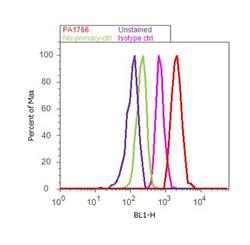Antibody data
- Antibody Data
- Antigen structure
- References [8]
- Comments [0]
- Validations
- Flow cytometry [1]
Submit
Validation data
Reference
Comment
Report error
- Product number
- PA1-766 - Provider product page

- Provider
- Invitrogen Antibodies
- Product name
- Anti-VAMP2 Polyclonal Antibody
- Antibody type
- Polyclonal
- Antigen
- Synthetic peptide
- Description
- PA1-766 detects vesicle associated membrane protein 2 (VAMP-2) from rat and mouse tissues. PA1-766 has been successfully used in Western blot, immunofluorescence, and immunoprecipitation procedures. By Western blot, this antibody detects a 19 kDa protein representing VAMP-2 from rat brain whole protein extract. The PA1-766 immunogen is a synthetic peptide corresponding to residues M(1) S A T A A T V P P A A P A G E G G(18) C of rat VAMP-2. This immunizing peptide (Cat. # PEP-101) is available for use in neutralization and control experiments.
- Reactivity
- Mouse, Rat
- Host
- Rabbit
- Isotype
- IgG
- Vial size
- 100 µg
- Concentration
- 1 mg/mL
- Storage
- -20° C, Avoid Freeze/Thaw Cycles
Submitted references Cellular compartmentation of energy metabolism: creatine kinase microcompartments and recruitment of B-type creatine kinase to specific subcellular sites.
Compensatory Islet Response to Insulin Resistance Revealed by Quantitative Proteomics.
The Rab-GTPase-activating protein TBC1D1 regulates skeletal muscle glucose metabolism.
Contraction-related stimuli regulate GLUT4 traffic in C2C12-GLUT4myc skeletal muscle cells.
Cleavage of SNAP-25 and VAMP-2 impairs store-operated Ca2+ entry in mouse pancreatic acinar cells.
Evidence that an isoform of calpain-10 is a regulator of exocytosis in pancreatic beta-cells.
The septin CDCrel-1 is dispensable for normal development and neurotransmitter release.
Tissue expression of the vesicle protein pantophysin.
Schlattner U, Klaus A, Ramirez Rios S, Guzun R, Kay L, Tokarska-Schlattner M
Amino acids 2016 Aug;48(8):1751-74
Amino acids 2016 Aug;48(8):1751-74
Compensatory Islet Response to Insulin Resistance Revealed by Quantitative Proteomics.
El Ouaamari A, Zhou JY, Liew CW, Shirakawa J, Dirice E, Gedeon N, Kahraman S, De Jesus DF, Bhatt S, Kim JS, Clauss TR, Camp DG 2nd, Smith RD, Qian WJ, Kulkarni RN
Journal of proteome research 2015 Aug 7;14(8):3111-3122
Journal of proteome research 2015 Aug 7;14(8):3111-3122
The Rab-GTPase-activating protein TBC1D1 regulates skeletal muscle glucose metabolism.
Szekeres F, Chadt A, Tom RZ, Deshmukh AS, Chibalin AV, Björnholm M, Al-Hasani H, Zierath JR
American journal of physiology. Endocrinology and metabolism 2012 Aug 15;303(4):E524-33
American journal of physiology. Endocrinology and metabolism 2012 Aug 15;303(4):E524-33
Contraction-related stimuli regulate GLUT4 traffic in C2C12-GLUT4myc skeletal muscle cells.
Niu W, Bilan PJ, Ishikura S, Schertzer JD, Contreras-Ferrat A, Fu Z, Liu J, Boguslavsky S, Foley KP, Liu Z, Li J, Chu G, Panakkezhum T, Lopaschuk GD, Lavandero S, Yao Z, Klip A
American journal of physiology. Endocrinology and metabolism 2010 May;298(5):E1058-71
American journal of physiology. Endocrinology and metabolism 2010 May;298(5):E1058-71
Cleavage of SNAP-25 and VAMP-2 impairs store-operated Ca2+ entry in mouse pancreatic acinar cells.
Rosado JA, Redondo PC, Salido GM, Sage SO, Pariente JA
American journal of physiology. Cell physiology 2005 Jan;288(1):C214-21
American journal of physiology. Cell physiology 2005 Jan;288(1):C214-21
Evidence that an isoform of calpain-10 is a regulator of exocytosis in pancreatic beta-cells.
Marshall C, Hitman GA, Partridge CJ, Clark A, Ma H, Shearer TR, Turner MD
Molecular endocrinology (Baltimore, Md.) 2005 Jan;19(1):213-24
Molecular endocrinology (Baltimore, Md.) 2005 Jan;19(1):213-24
The septin CDCrel-1 is dispensable for normal development and neurotransmitter release.
Peng XR, Jia Z, Zhang Y, Ware J, Trimble WS
Molecular and cellular biology 2002 Jan;22(1):378-87
Molecular and cellular biology 2002 Jan;22(1):378-87
Tissue expression of the vesicle protein pantophysin.
Windoffer R, Borchert-Stuhlträger M, Haass NK, Thomas S, Hergt M, Bulitta CJ, Leube RE
Cell and tissue research 1999 Jun;296(3):499-510
Cell and tissue research 1999 Jun;296(3):499-510
No comments: Submit comment
Supportive validation
- Submitted by
- Invitrogen Antibodies (provider)
- Main image

- Experimental details
- Flow cytometry analysis of VAMP2 was done on SH-SY5Y cells. Cells were fixed with 70% ethanol for 10 minutes, permeabilized with 0.25% Triton™ X-100 for 20 minutes, and blocked with 5% BSA for 30 minutes at room temperature. Cells were labeled with VAMP2 Rabbit Polyclonal Antibody (PA1766, red histogram) or with rabbit isotype control (pink histogram) at 3-5 ug/million cells in 2.5% BSA. After incubation at room temperature for 2 hours, the cells were labeled with Alexa Fluor® 488 Goat Anti-Rabbit Secondary Antibody (A11008) at a dilution of 1:400 for 30 minutes at room temperature. The representative 10,000 cells were acquired and analyzed for each sample using an Attune® Acoustic Focusing Cytometer. The purple histogram represents unstained control cells and the green histogram represents no-primary-antibody control.
 Explore
Explore Validate
Validate Learn
Learn Western blot
Western blot Immunocytochemistry
Immunocytochemistry Flow cytometry
Flow cytometry